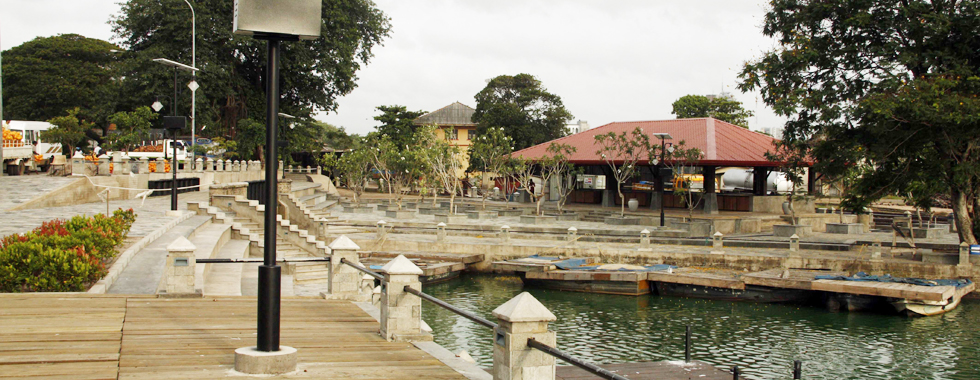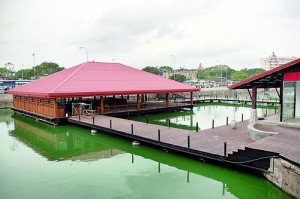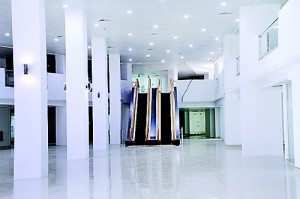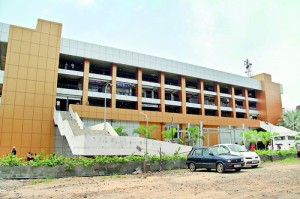New lustre for old Pettah
Before the advent of plush shopping malls, it was Pettah that was the hub for shoppers and it is still faithfully visited by determined bargain hunters, who comb the crowded streets and bustling shops for a purchase. Pettah admittedly lost some of its lustre in recent years but the Ministry of Defence and the Urban Development Authority that have implemented a number of projects including the city beautification programme, and refurbishment of old buildings, in their drive to make Colombo a Garden City, have now turned their attention to this city centre.

Once a smelly water body metamorphosing into a floating market. Pix by Indika Handuwala
Two projects- the Gold City and the Floating Market soon to be opened will see the beginnings of the transformation.
The Gold City will, believe it or not, be sited at St. John’s market (the old fish market) built in 1894 by the British when the chairman of the Colombo Municipal Council was C.E.D. Pennywick. Bordered by Reclamation Road (renamed NHM Abdul Cader Mawatha), Gabos Lane and Sea Street, the building was turned into a five storeyed complex in 1983. The first two floors functioned as the fish market and the upper floors served as a wholesale market. Known as St. John’s fish market- the name coming from St. John’s road which ran adjacent to it, the whole complex was later named Colombo Central Super Market.
 After the fish market was moved to Peliyagoda, the building lay vacant and dilapidated. It had been the idea of the Secretary of the Ministry of Defence and Urban Development, Gotabaya Rajapaksa to build a “Gold City” in the complex. As part of the first stage of the Rs. 400 million project, the first two floors of the building have been refurbished as a centre for bullion.
After the fish market was moved to Peliyagoda, the building lay vacant and dilapidated. It had been the idea of the Secretary of the Ministry of Defence and Urban Development, Gotabaya Rajapaksa to build a “Gold City” in the complex. As part of the first stage of the Rs. 400 million project, the first two floors of the building have been refurbished as a centre for bullion.
“The concept of a central location for gold, gem and jewellery trading is successful in many countries. The concept is targeted towards tourists and corresponds with our aim to make Colombo a top tourist attraction as the commercial capital of Sri Lanka. The idea was to bring the shops in Sea Street (Hetti Weediya) famous for its gold shops to one location,” said the former Deputy Director General of the UDA, senior consultant Weerasena Adikari. They hope to declare open the new complex at the end of July.
Architectural input for the project is by Avanti Jayasinghe. The newly built Gold City includes 83 shopping spaces, 48 on the first floor  and 35 in the second, two bank spaces and the Gem and Jewellery Authority. A multi storeyed parking lot has been planned in front of the complex. Most shops have been taken by gold merchants, but some shops are still vacant. No major structural changes have been made to the building although timber floors, escalators have been added as well as access for the disabled. Security will also be provided. The project will be marketed at the airport and a shuttle service is also on the cards from hotels to the complex.
and 35 in the second, two bank spaces and the Gem and Jewellery Authority. A multi storeyed parking lot has been planned in front of the complex. Most shops have been taken by gold merchants, but some shops are still vacant. No major structural changes have been made to the building although timber floors, escalators have been added as well as access for the disabled. Security will also be provided. The project will be marketed at the airport and a shuttle service is also on the cards from hotels to the complex.
The Floating Market meanwhile is coming up at Bastian Street in Pettah. When construction began in March 2013, people hardly even knew there was a waterbody behind the shops and those who knew it thought of it as a smelly garbage dump. The UDA along with the Army’s Engineering Services Regiment have taken on the task of purifying the water, cleaning the surrounding areas and building the floating market complex.

Quite a transformation: From a fish market to a “Gold City” complex (above and below)
“There were a lot of unauthorised constructions in the surrounding areas. This was also an unutilised area. Pettah is also the most crowded area in Sri Lanka and so the water body is extremely important,” Mr. Adikari said.
The new complex consists of five structures and 92 shops with 15 stalls selling local crafts with tourists in mind. A car park as well as walkways around the premises and its location in between the train station and the bus stop ensures easy access. Security will be provided around the clock, say the planners, inviting shoppers to enjoy the breeze and the surroundings. The water purification project is done under the UDA as part of the development of the Beira Lake.
“The water quality management is a constant process as the algae concentration in the area is high. The CMC, the Central Environmental Authority as well as the Ports Authority will undertake the purification system. The biggest responsibility is with the general public to maintain it,” said Mr. Adikari.
“The biggest positive return for us was to see the people’s attitude change. When everything is beautiful, people feel responsible towards it. We hardly see anyone throwing litter on the road. The culture associated with Pettah and Colombo is changing and we are thankful to the public for it. We hope this continues,” adds Mr. Adikari.
Both projects are carried out by the Army 4th ESR led by Sergeant Major Prasad. UDA Chairman Nimal Perera and Director General Harshan de Silva are also overseeing the project.



